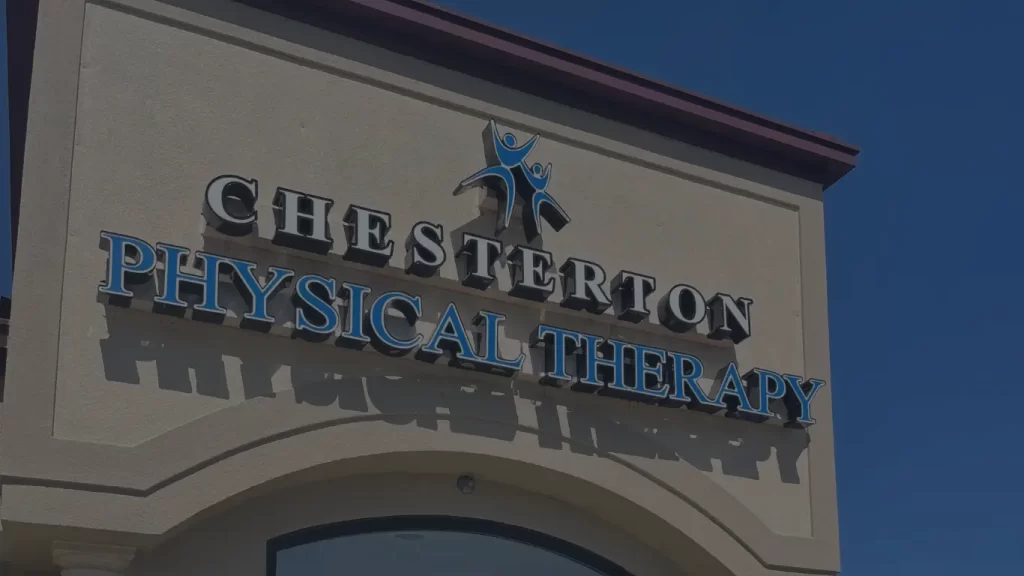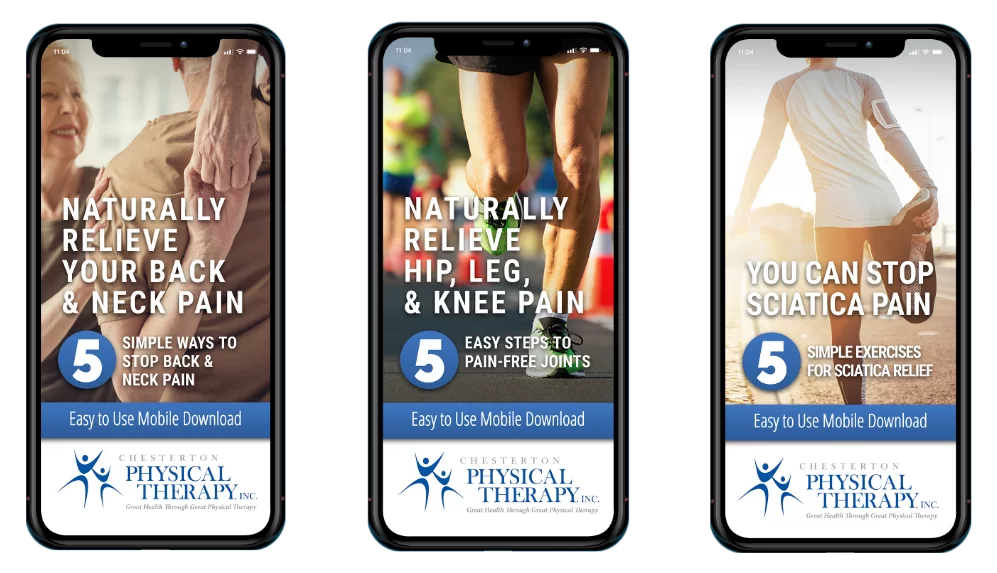Health Blog
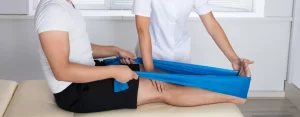
Are You Living with Any of These 5 Conditions? If So, Consider PT!
Are You Living with Any of These 5 Conditions? If So, Consider PT! 5 Signs You May be in Need of Physical Therapy! Did you know that PT can be used to manage a variety of different conditions as a natural form of pain relief? Unfortunately, it is usually not only until after attempting more conventional medical approaches such as surgery and prescription painkillers that people realize physical therapy sessions are a fantastic way to relieve their chronic pain and other recurrent symptoms. If you have any of these top five most common aches and pains, you may be a good candidate for physical therapy. Our innovative care strategies at Chesterton Physical Therapy will help you find quick relief. Keep reading to learn more about common conditions that can be treated with PT and some of the top natural healing recommendations from our experienced physical therapists! Do any of these sound like you? 1. Traumatic Injury After experiencing a traumatic injury, your body requires plenty of time to heal and recover. But in today’s busy world, many people must get back to work as soon as possible following an injury. Physical therapy can help your body to heal more quickly and efficiently after a traumatic injury or surgery. Physical therapy is an ideal post-surgical healing option and designed to help you reach your rehabilitation goals without the use of prescription pain medications. 2. Joint Pain Arthritis and other forms of joint pain can increase in severity as we age. However, people of all ages are at risk of developing joint pain, especially following another traumatic injury. And for those who are overweight or obese, joint pain can become a chronic health issue that prevents one from enjoying the simple things in life like taking a walk after mealtimes or getting in and out of the car with ease. Joint injuries don’t always happen because of an accident. They can also develop slowly over months or even years. You might notice that the pain also ebbs and flows depending on the time of day. Certain sports, jobs, hobbies can cause you to put excessive stress on certain joints over and over again, which could very well lead to pain. Working with a physical therapist to develop a personalized treatment plan can help to manage your joint pain and other symptoms naturally. 3. Neck Pain It’s common to experience neck pain for a variety of different reasons. You may notice neck pain spring up after an auto accident or as a result of poor posture. Neck pain is often very difficult to cope with and treat with traditional medicine. However, PT and massage can relieve the muscles in the neck, reduce swelling, and help to restore your natural mobility. Physical therapy, regardless of the root cause of pain, has been shown to help with neck pain. For those trying to prevent costly procedures or dangerous drugs, PT is a completely safe, natural, and effective mode of care. 4. Headaches Recurring headaches are no laughing matter and can make getting through the day seem nearly impossible. In many cases, frequent headaches are a sign of injury in the neck or back. Working with a physical therapist to target the cause of your recurring headaches can reduce the severity of your head pain or eventually eliminate them altogether. In fact, as stated by Choose PT, “There is effective treatment for almost every type of headache.” Working with a physical therapist can help you identify tension-reducing exercises and help you find long-term relief from headaches without the need to rely on pain medication. 5. Back Pain Back pain is one of the biggest reasons that Americans visit the doctor each year. Back pain can be the result of a wide variety of different injuries, illnesses, and chronic conditions. The World Health Organization estimates that in the United States, 149 million days of work are lost due to low back pain. You may be experiencing back pain due to an overuse injury, a degenerative disease, sports injury, or other common environmental factors. But whatever the cause, there’s a good chance that your back pain is preventing you from completing simple everyday tasks like getting out of bed or climbing the stairs without feeling pain. Physical therapy can help to address the root cause of your pain, increase mobility, reduce inflammation and much more. Contact Our Physical Therapist Today If you or a loved one are struggling with recurrent pain after injury or as a result of a degenerative condition, physical therapy is a great way to help your body to heal naturally. Are you interested in learning more about the benefits of physical therapy for pain management and healing? Please contact our knowledgeable and friendly physical therapist for more information and be sure to schedule your initial consultation today!

Not Feeling Your Best? Proper Nutrition Can Help!
Not Feeling Your Best? Proper Nutrition Can Help! Feel Like Yourself Once Again with Nutritional Changes In your daily struggle against pain and inflammation, are you reaching for a pill bottle, or are you looking for a healthy lifestyle change? That latter choice will do more for you in terms of long-term function, mobility, and safety. But what kinds of lifestyle changes should you pursue? In addition to regular exercise, including the types of targeted exercises you might receive in physical therapy, you should examine your sleep, your workplace ergonomics – and your nutrition. Our innovative care strategies at Chesterton Physical Therapy will help you find quick relief. Here are five ways that proper nutritional strategies can help you control your pain and inflammation. 1. Decreased inflammation Your gut flora have a lot of influence on your overall health and comfort. Eating whole grains, lentils, avocado, low-fat yogurt and other probiotic foods can help you maintain high levels of “good bacteria” in your gut. This positive balance can help reduce inflammation throughout the body. 2. Muscle strengthening Weak muscles are more vulnerable to injury, pain and inflammation; they also allow your posture to sag, throwing your weight off-balance, subjecting your entire musculoskeletal system to unnecessary discomfort. Physical therapy exercises can help, but your muscles still need the basic building material known as protein. Getting plenty of lean, healthy proteins (from foods that are relatively low on the inflammation scale) can help you build a body that resists pain and injury. 3. Weight loss Obesity has been associated with all kinds of problems, from heart diseases and type 2 diabetes to liver disease and certain kinds of cancer. But did you know that obesity also hurts? Those added pounds can put a lot of stress on your joints and muscles, especially in the back, hips, knees and feet, where they can contribute to osteoarthritis development. If the rising number on the scale corresponds to rising pain levels, the right dietary changes can turn things around. Focus on foods that are rich in nutrients, low in fat and sugar, and served in sensible portion sizes. You’ll shed pain as you shed pounds! 4. Immune system regulation When your immune system malfunctions, pain often results. Autoimmune disorders are responsible for such painful chronic conditions as rheumatoid arthritis. Eating foods rich in omega-3 fatty acids, zinc, selenium, probiotics, and vitamins A and D can help you avoid or control autoimmune diseases, thus helping you enjoy greater comfort and a higher standard of overall wellness. 5. Anti-inflammatory foods Why get your anti-inflammatory effects from an NSAID or steroid when you can get them from the foods you eat every day? Many of the menu items in the traditional Mediterranean diet, for instance, possess natural anti-inflammatory properties. Foods such as whole grains, fatty fish, olive oil, turmeric, cherries, and cayenne pepper can reduce inflammation and the pain that comes with it. At the same time, you’ll be eating fewer inflammatory foods such as red meat, fried foods and processed meats, turning the pain management scales decidedly in your favor. Can nutrition help with my condition? There are a number of common conditions that directly relate to nutrition and diet. Here are some of the conditions in which nutrition advice is likely to be part of the patient’s physical therapy regimen: Inflammation: American diets tend to have a lot of vegetable oils and other inflammatory foods in them. This can make the pain from inflammation even worse. In many cases, a physical therapist will prescribe a diet with more antioxidants and anti-inflammatory foods to help manage pain. Obesity: Pain related to obesity can become a vicious cycle. Being overweight causes a patient pain, so they become more sedentary. Becoming more sedentary causes them to gain more weight, which leads to more pain. Osteoarthritis: Obese patients are more likely to develop arthritis, especially in the knee. Once a person has been diagnosed with osteoarthritis of the knee, managing their weight becomes the most important key to managing the arthritis and pain. Autoimmune Disorders: The combined total of various autoimmune disorder patients (such as Crohn’s disease, multiple sclerosis, type 1 diabetes and rheumatoid arthritis) now outnumber cancer patients in America by a wide margin. Autoimmune disorders are frequently linked directly to deficiencies in a patient’s diet. Diabetes: Diabetes and pre-diabetes pave the way for more serious conditions such as heart disease, kidney disease and blindness. More than 90 percent of patients with diabetes also experience neuropathic pain. Diet and nutrition will play a key role in managing these conditions. Need more assistance? Our physical therapist has a detailed understanding of how nutrition (both good and bad) affects physical health, well-being, and comfort. If you have been dealing with chronic pain and inflammation, contact our physical therapy clinic. We can evaluate your situation and recommend the necessary changes to make you feel better!

Are You Dependent on Opioids For Pain Relief?
Are You Dependent on Opioids For Pain Relief? If you depend on pain medications to make it through the day because of a chronic pain condition, know that you are not alone. You should also know that even though this is a common pain relief solution for many Americans, it is not normal or healthy in the slightest. Our nation is currently experiencing what the U.S. Department of Health & Human Services refers to as an “opioid epidemic.” Thankfully, there is another option for this kind of pain management. Physical therapists can help individuals manage pain, and greater use of physical therapy could make a real impact on the tragic levels of drug abuse in this country—abuse that often begins with a prescription for pain medication. Our innovative care strategies at Chesterton Physical Therapy will help you find quick relief. If you are ready to find relief without the side effects of opioids, contact our physical therapy clinic today. Why are opioids so dangerous? People often confuse over-the-counter drugs and opioids, but they’re two different things. When people turn to over-the-counter medications for pain relief, there aren’t many significant health risks. For the most part, Advil, Tylenol, and Ibuprofen are safe to use in moderation if you are trying to find immediate relief when recovering from your car accident. Excessive use can negatively affect your organs, but most people don’t need to use these pain relievers very often. When it comes to severe pain caused by a more serious injury you may have sustained, prescription-strength medications may be issued by a doctor. However, with severe pain comes severe medication and side effects as well. Opioids are the most commonly used medication for pain management across the United States. Even though they are common, there are some shocking facts about them that the general public might not even be aware of, such as: Opioids are a highly dangerous class of substances. Heroin is among the opioid category, as well as prescription pain relievers like oxycodone, hydrocodone, morphine, and more. Opioids are a highly addictive substance and are the most commonly abused prescription medication. More than 2 million people in the United States become addicted to pain medication every year, many of the medications being opioids. About a quarter of heroin addicts began their addiction through prescription opioid dependency. These facts paint a bleak picture regarding the reality of prescription pain medication use across the United States. While disturbing, these statements cannot be ignored. It isn’t necessary to have a history of addiction to become dependent on opioids. In fact, many people who become addicted have never had any issues with drug dependency in the past. Fortunately, physical therapy can help provide the same pain relief in a much safer, healthier, and natural way. How physical therapy can kick an opioid addiction Physical therapy is effective for avoiding unnecessary surgery and for getting rid of a person’s dependence on opioids. This is why physical therapy is often the first point of entry in the healthcare system for pain management. The goal of physical therapy is to improve function and reduce pain. Both active and passive modalities are used in many forms of treatment. A physical therapist will educate you on the source of your pain and give you tips on how to manage your daily activities in order to reduce or eliminate pain. Pain education is an important component of physical therapy intervention! What to expect at a physical therapy appointment Chronic pain can make you curl up in bed and turn to opioids for pain relief. This solves nothing and is likely to only make your problem worse. If you’re tired of living with addiction, understand that you can say “no” to opioids with the help of physical therapy. It’s important to note that physical therapy can be implemented to treat all types of neuropathic pain and musculoskeletal pain. It can help alleviate pain due to osteoarthritis, fibromyalgia, rheumatoid arthritis, neuropathic pain, headaches, and more. A physical therapist utilizes a number of different pain management methods, such as deep tissue massage, manipulation of bones, manual therapy, cold laser therapy, microcurrent stimulation, movement therapy, and exercise. Exercise may involve walking on a treadmill or specific exercises to strengthen the muscles. Deep tissue massage enhances oxygen and nutrients to travel to the affected area. Cold laser therapy is used to lessen pain, reduce inflammation and release endorphins. Microcurrent stimulation emits alpha waves to increase dopamine and serotonin to alleviate pain naturally. Even just 30 minutes of exercise a day will help you to better manage your pain! The exercise plan that a physical therapist will devise for you will be focused on strengthening the muscles, increasing endurance, developing more flexibility in the joints and muscles, and creating stability in the joints. Physical therapy is a multi-pronged approach to lessening pain. With exercise, massage, and manipulation, the body is encouraged to produce natural pain-relieving chemicals and to heal itself. Both tissue and bone will remodel with physical therapy. A physical therapist uses the fundamental sciences of biomechanics, pathology, and kinesiology to formulate a specific exercise treatment plan for patients. They can work closely with you and your doctor to find an effective treatment plan for your pain. Get started today If you’re tired of using pain medication to lessen your discomfort, know that there is another way to handle this part of your life. You don’t want to be part of a negative statistic. Contact us to schedule a consultation with one of our physical therapists – and say goodbye to opioids today.

Living with Joint Pain? PT Can Help in These 4 Ways
Living with Joint Pain? PT Can Help in These 4 Ways Arthritis is a common joint pain problem that can affect people of all ages. While there is no cure for arthritis, with physical therapy, you can learn how to manage your arthritis pain naturally. For many people with chronic arthritis pain, prescription pain medications may seem like the only way to relieve pain. However, our experienced physical therapist recommends completing a variety of targeted exercises to reduce inflammation, increase mobility, and relieve your arthritis pain. Our innovative care strategies at Chesterton Physical Therapy will help you find quick relief. Keep reading to learn more! How can physical therapy help relieve painful joints? If you have arthritis pain, our physical therapist recommends completing a few different physical therapy exercises to help ease your pain and other symptoms, such as stiffness. Some of our favorite exercises are: Hand Exercises — Rheumatoid arthritis can often result in limited use of the hands over time. By bending the wrists up and down, slowly curling your fingers, and spreading your fingers wide in a repetitive exercise cycle, you can greatly improve mobility and relieve chronic pain. Water Exercises — This is a great low-impact way to get in your physical therapy exercises and relieve joint pain. Walking — Going for a walk is a great way to improve your joint health, boost your overall mood, and help with aerobic conditioning. Stretching — This simple exercise helps to improve flexibility, increase your range of motion and reduce stiffness caused by arthritis. So, why am I experiencing joint pain? Because there are different types of arthritis, there is no major cause of this type of joint problem. There are, however, certain risk factors that may increase the likelihood that you may develop arthritis in your lifetime. Gender Did you know that women are much more likely to develop rheumatoid arthritis than men? But on the other hand, men are more likely to develop gout. Age The risk of developing certain types of arthritis, like osteoarthritis and gout, increases as we age. Previous Injury If you’ve injured a joint in the past, you have an increased risk of developing arthritis in the same area later in life. Weight When you are carrying excess weight on your body, you are putting increased strain on your joints. People with obesity have a greater chance of developing arthritis, particularly in the knees, hips, and spine. Family History Certain types of arthritis can be genetic issues that run within family lines. If your parents or siblings have a specific type of arthritis, you are much more likely to develop it at some point in your life as well. How else can joint pain develop? Can you believe that it’s possible to develop soft tissue pain from doing absolutely nothing? It’s strange, but true. Take for example, this condition called adhesive capsulitis, otherwise known as “frozen shoulder.” If you’ve had to wear a sling for a while, this is an uncomfortable condition you could end up having that can render your shoulder useless for quite some time. Osteoarthritis is the most common condition that causes pain and stiffness. This condition can affect anyone at any age, but is most commonly found in older patients due to age-related deterioration of cartilage between bones in the joint. Osteoarthritis isn’t the only one to look out for. Rheumatoid arthritis is another painful, damaging joint condition caused by autoimmune problems. Do you have any of these symptoms? For most people with arthritis, joint pain is the most common complaint. But depending on the type of arthritis an individual has, they may experience a variety of different symptoms, including: Chronic pain Impaired range of motion Stiffness Redness Swelling What else should I know about arthritis? Arthritis is characterized by swelling or tenderness in one or more of the body’s joints. Joint pain and stiffness are the most common complaints of those with arthritis, and these symptoms may actually worsen with age. While there are many types of arthritis, the two most common types are rheumatoid arthritis and osteoarthritis. With osteoarthritis, the cartilage that covers the ends of the bones in the joint begins to break down, resulting in recurring pain and stiffness. However, rheumatoid arthritis is a chronic disease that causes the body’s immune system to attack different joints, starting with the actual lining of the joints and breaking them down over time. Our trained physical therapists are dedicated to helping you achieve a pain-free life. Consult with a licensed PT today Are you interested in learning more about the benefits of physical therapy for arthritis pain? Please contact our Chesterton, IN physical therapy practice to learn more, and be sure to schedule an initial consultation.
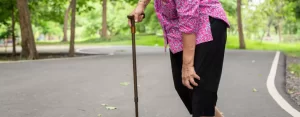
Discover Lasting Relief for Your Hip and Knee Pains
Discover Lasting Relief for Your Hip and Knee Pains Are You Living with Hip and Knee Pains? The knee is considered to be a hinge joint while the hip is a ball-and-socket joint. They are both complex joints with a network of muscles, tendons, ligaments, bones, and cartilage – all working together to keep you moving. With these many moving parts, it’s not surprising that as we age or engage in strenuous activity, we sometimes experience pain. If you suffer from hip or knee pain, it can make it difficult to do even the most basic daily activities. Understanding the causes of hip and knee problems is often the first key to effective treatment. A physical therapist can help you reduce or even eliminate the amount of pain you’re experiencing if you’re struggling with hip or knee pain. Our innovative care strategies at Chesterton Physical Therapy will help you find quick relief. What can I expect from a PT treatment plan? Physical therapy may offer a non-invasive solution for both hip and knee pain. Your physical therapist is likely to begin with an evaluation. In the case of knee pain, the evaluation would probably focus on the area from the hip to the foot. Evaluation of hip pain is also likely to include a spinal evaluation. For both types of pain, the assessment may include a range of motion and strength measurements. Your physical therapist may also perform gait and mobility tests. An individualized physical therapy program would then be developed to meet your specific needs. Physical therapy can improve your joint function while also easing your pain and stiffness. Our physical therapist can prescribe exercises aimed at addressing your specific condition, such as: Mini-squats Heel-to-buttock-exercises Hip rotations Knee lifts Leg lifts Step exercises Hamstring curls Hip flexion, extension or abductor exercises The American Physical Therapy Association states that early rehabilitation for certain types of knee pain is associated with lower use of opioids and knee surgery. Various types of exercises are often used to reduce pain in the hips. Passive methods, such as icing or heat treatment, could also be used to eliminate pain. Sometimes soft tissues and joints in the hip or spine must be manipulated to restore proper movement and reduce pain. A variety of exercises and stretches are also used to treat pain in the knee. Other treatments that your physical therapist may use include ultrasound or electrical stimulation. What do additional treatments look like? Surgery: Recovery from surgery can be painful and extensive. There’s always the chance of infection and sometimes surgery simply doesn’t produce the intended results. While surgery may be effective in some cases, it’s not without its drawbacks and should be used as a last resort. Pain Medication: Prescription pain meds are sometimes used to treat knee and hip pain. Medication normally doesn’t solve the issue, but only temporarily reduces the pain. Medications, even over-the-counter meds, can be addictive and expensive. So, why am I experiencing hip/knee pain? There may be one or several reasons why you are experiencing hip and knee pain. A physical therapist can examine your movement to help identify things that are contributing to your pain, such as poor posture, unhealthy walking patterns, or unhealthy movement patterns at work. Once they identify these kinds of issues, physical therapists can tell you how to correct them. Some common causes of knee and hip pain are as follows: Knee Pain: Injuries that include torn cartilage or damaged ligaments can cause knee pain. Fractures, tendinitis, and knee bursitis are all common knee injuries. Medical conditions such as arthritis or gout can cause mild to severe knee pain. You may be experiencing stiffness or swelling in one or both knees. It might be difficult to stand, walk, or fully straighten your knee. Sometimes knees will make popping or crunching noises. Hip Pain: Hip pain can be caused by a variety of medical conditions as well as by certain injuries. Inflamed tendons from over-exertion or an athletic injury can cause temporary or chronic hip pain. Tendinitis, dislocation, sprains, and pinched nerves can all contribute to or be the cause of hip pain. Hip pain may also result from repetitive injuries or poor posture. Get started on a treatment plan today! It is important to follow all the instructions of your physical therapist, including any stretches or exercises that can be done at home. Your physical therapist can conduct a thorough examination of your body, pinpoint the areas in your hips and knees where you’re struggling with pain, and create a customized program to treat your particular condition. Physical therapy can help you find lasting relief from pain in the hip or knee! Contact us today in Chesterton, IN to find out for yourself.
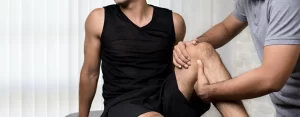
Joint Pain Got You Down? Physical Therapy May Help.
Joint Pain Got You Down? Physical Therapy May Help. If you’ve been dealing with chronic joint pain for some time, then you should know you’re not alone. Chronic joint pain is typically associated with arthritis, although there are plenty of other physical ailments that can lead to joint deterioration and pain. While physical therapy is not a cure for arthritis, it can help to alleviate the pain, increase your range of motion in the affected joints and help you get control over the problem so that it doesn’t get worse. If you are not proactive when it comes to joint pain, it likely will worsen over time, especially if you’re relying on prescription medications to provide pain relief. Our innovative care strategies at Chesterton Physical Therapy will help you find quick relief. If you’ve been suffering from joint pain and now you’re looking for a solution, call us to schedule an appointment with a physical therapist. Is your joint pain a sign of arthritis? Did you know that arthritis is the leading cause of disability across the United States? According to the Arthritis Foundation, approximately 50 million people live with arthritis. While it is possible for arthritis to develop in any joint, it most commonly affects the neck, back, hands, hips, and knees. It can also affect people of any age. There are two main types of arthritis that are the most common culprits when it comes to joint pain: osteoarthritis and rheumatoid arthritis. Here is a closer look at these types of arthritis and how they affect your joints: Rheumatoid Arthritis: If you have been diagnosed with rheumatoid arthritis, your doctor will likely prescribe pharmaceutical treatments to decrease your pain and discomfort. This is an autoimmune disorder in which the body’s healing systems attack the joints. Rheumatoid arthritis causes painful swelling and inflammation of the joints. Although this condition usually begins in the hands, wrists, or feet, it can spread to the hips, knees, or shoulders, while getting progressively worse, if you aren’t proactive in fighting it. Physical therapy can be a tremendous help to those dealing with this autoimmune disease. Osteoarthritis: Osteoarthritis typically develops later in life and can be caused by poor body mechanics, overuse of the joint, or an injury. This is the most common type of arthritis by far. The cartilage in joints serves as a natural barrier that lubricates and distributes force during physical activity. When that cartilage breaks down and no longer provides a cushion between adjoining bones, the result is osteoarthritis. The hands, hips, knees, and spine are the most common body parts impacted by osteoarthritis. Certain ailments like gout, bursitis, lupus, or tendinitis can also contribute to joint pain. The source of your joint pain can be determined by a combination of tests that a physical therapist can perform, as well as a thorough examination. What can a physical therapist do for joint pain? Your therapist will need to know about the type of joint pain you are experiencing, the times of day when the pain is worse, and any physical activities that you engage in on a regular basis If you have a job that requires physical labour or sitting at a desk all day, tell them. If your condition has already been diagnosed by a doctor, your physical therapist should be made aware of this as well. Your therapist will likely run you through a series of simple strength tests during your first visit. These will be done to test your range of motion, balance, and posture. This information will be used to help create a customized physical therapy regimen to help you relieve the joint pain while strengthening muscles to help support the joints. Your plan of physical therapy will likely contain a combination of targeted stretches, exercises, manual therapy, and body mechanics. Manual therapy is a specialized type of therapeutic massage that your physical therapist is trained in; manual therapy can help to soften tissues and relieve pain associated with your joint condition. Body mechanics involves teaching you the proper way to move, sit, stand, lift objects, and engage in other daily activities, without causing pain to your joints. The exercises will likely be low-impact to relieve pressure on the joints while strengthening your muscles, such as water aerobics. Common symptoms of joint pain or arthritis For most people with joint pain, general discomfort is the most common complaint. But depending on what the cause of your joint pain is, you may experience a variety of different symptoms, including, but not limited to the following: Chronic pain Impaired range of motion Stiffness Redness Inflammation of the affected area Inability to grasp objects Swelling If you’re noticing any of the above symptoms, there are two things you should not do. First, don’t expect it to go away on its own. Second, don’t rely on prescription medications for temporary relief. Call a physical therapist at our office today to learn more about the causes of joint pain, and find out how you can begin keeping your own at bay. Are you ready to find relief today? You deserve a normal, healthy, active lifestyle. The goal of your physical therapy will be to help you take back control of your life by minimizing joint pain. Call our office today to schedule your first appointment with a physical therapist.


